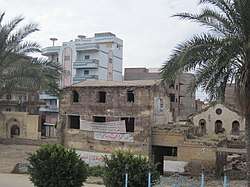Fuwwah
Fuwwah (Arabic: فوه; Coptic: ⲃⲟⲩⲁ)[1] is a city in the Kafr El Sheikh Governorate, Egypt.[2]
Fuwwah Ⲙⲉⲗⲉϫ Ⲙⲉϫⲏⲗ Ⲙⲏϫⲏⲗ فوه | |
|---|---|
City | |
 Remnants of the Fez Factory in Fuwwa | |
 Fuwwah Location in Egypt | |
| Coordinates: 31.203258°N 30.550354°E | |
| Country | |
| Governorate | Kafr El Sheikh |
| Time zone | UTC+2 (EST) |
History
| mtlȝ[4][5] in hieroglyphs |
|---|
Fuwwah is identified with the ancient Metelis (Coptic: Ⲙⲉⲗⲉϫ, Ⲙⲉϫⲏⲗ and Ⲙⲏϫⲏⲗ; Ancient Greek: Μέτελις, Μέτελος or Μέτηλις), the capital of the Metelite nome (the 7th nome of Lower Egypt).[4]
Medieval Fuwwah grew to become one of the most important cities in al-Dimashqi's time, when he compared its size to that of Cairo. Fuwwah's prosperity owed largely to the decline of Rosetta at that time. Fuwwah was the capital of a province variously called Fuwwah or Al-Muzahamiyatayn.[1]
Fuwwah's Christian bishopric remained active through the late thirteenth century, indicating the presence of a large Christian population at the time. Its location on the Rosetta branch of the Nile meant that residents could easily travel by boat, the main mode of transport in the Nile Delta at the time - overland travel was potentially dangerous, as evidenced by the inability of Yusab, the bishop of Fuwwah, to travel to the Synod of 1250 due to Bedouin raids.[6]
One of the most important monuments in Fuwwah is the Fez factory established in 1824 by an order from Muhammed Ali Pasha.[7]
The 1885 Census of Egypt recorded Fuwwah as a nahiyah under the district of Desouk in Gharbia Governorate; at that time, the population of the town was 9,902 (4,805 men and 5,097 women).[8]
References
- Maspero, Jean; Wiet, Gaston (1919). Matériaux pour servir à la géographie de l'Égypte. Cairo: Institut français d'archéologie orientale. p. 141.
- "بوابة الأهرام". Retrieved 5 July 2013.
- Goitein, Shelomo Dov; Sanders, Paula (1967). A Mediterranean Society: Daily life. University of California Press. p. 406. ISBN 0520048695. Retrieved 22 June 2020.
- Gauthier, Henri (1926). Dictionnaire des Noms Géographiques Contenus dans les Textes Hiéroglyphiques Vol. 3. p. 64.
- Wallis Budge, E. A. (1920). An Egyptian hieroglyphic dictionary: with an index of English words, king list and geological list with indexes, list of hieroglyphic characters, coptic and semitic alphabets, etc. Vol II. John Murray. p. 1003.
- Tsuji, Asuka (2017). "The Veneration of Anba Hadid and the Nile Delta in the Thirteenth Century". In Gabra, Gawdat; Takla, Hany N. (eds.). Christianity and Monasticism in Northern Egypt: Beni Suef, Giza, Cairo, and the Nile Delta. Oxford University Press. pp. 189–90. ISBN 1617977802. Retrieved 24 June 2020.
- "الحكومة تتشاجر على مصنع الطرابيش بكفر الشيخ.. والشباب يريد استغلاله (صور)". www.tahrirnews.com (in Arabic). Retrieved 2018-11-26.
- Egypt min. of finance, census dept (1885). Recensement général de l'Égypte. p. 114. Retrieved 22 June 2020.